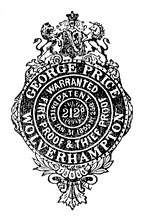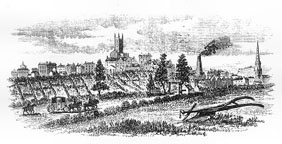[Part 1 of A Gazetteer of Lock and Key Makers, which the author has kindly shared with readers of the Victorian Web. Readers who wish to check out the original site can find it by clicking here.]
Introduction
Search through the indexes of general history books from the eighteenth century onwards for a mention of locks and locksmiths, and you will find nothing. Yet without security systems there would be precious little of our heritage left.
In the middle of the nineteenth century George Price of Wolverhampton, who had just set up as a manufacturer of fire resistant safes, published such a history. A first edition of his Treatise, listed as "the standard and most comprehensive work of its kind" is on offer on a rare books website, September 2002, at ’575.52. Locksmiths and collectors all over the world use photocopies of it on an everyday basis.

The name plate and escutcheon used on Price's "Treble Patent" safes.
In 1856, the News of the World reviewed it as follows:
The recent robberies of merchants' counting houses and ingenious and sometimes successful attempts to open iron safes, have caused attention to be directed again to the subject of locks, keys and safes. Here we have a volume abounding with curious information .’ Mr. Price is obviously an authority upon fire-proof safes, and what he has to say deserves, and will receive, attention; he furnishes details of safes and locks and keys out of number and displays talent and ingenuity as well as a spirit of research. His volume will be found generally interesting, for it includes an entire history of the subject, with illustrations both curious and explanatory.
The Midland Counties Herald commented:
The subjects of which this portly volume is the exponent are of very great importance to the banking, mercantile and trading classes -- to all, in short, who have cash and portable property of a valuable kind to guard from thieves or the ravages of fire.’
The Treatise is for the large part a history of locks from before biblical times, illustrated by five hundred woodblock illustrations. But it also includes a detailed account of some of the feuds which went on between competing manufacturers, including George Price's own feud with William Milner of Liverpool.
The Black Country in the nineteenth century
Until around 1760 the land around Wolverhampton, Willenhall, Bilston, Coseley and Wednesfield was described as "a district abounding in groves and streamlets and occupied by a pastoral population, while the iron and coal lay quietly beneath the surface, undisturbed by the restless cupidity of man." But by the time George was born, in 1819, "all trees, grass, flowers have vanished before the speculations of commercial enterprise and it has become a region of darkness and steam-engines. The fitful appearance of numerous detached fires, the hissing and booming of the furnace blasts, the loud and frequent reports like claps of thunder from the iron forges, the dense clouds of smoke which always envelop this sterile tract intersected by sluggish canals."

This "View of Wolverhampton in 1805", taken from Bisset's Grand National Directory of 1805, was re-printed in George Price's first treatise. The view appears to be from the Penn Road.
The landscape had become peppered with slag heaps, collapsing buildings and mineshafts. Some were sunk in the middle of streets, the coal being so plentiful and so near the surface. The land around the shafts collapsed regularly because the soil was so sandy, suffocating scores of miners who were working down there. Trains and carts clanked round the district loaded with coal to feed the fires and furnaces, which burned and roared twenty four hours a day in the small workshops of hundreds of smiths and ironfounders. Brassfounders' hair turned green from the smoke and chemicals produced by hot metals. The workshops were tucked away in the courts and passages of the area "as much out of sight as birds' nests". Unlike Manchester, Leeds and the northern mill towns, the Black Country had very few large factories.
In the late eighteenth century John Wilkinson, an ironmaster from Cumberland, who had previously worked in the coalfields of Wrexham, North Wales, had come to Bilston and hit on the formula for making iron using coke instead of charcoal. Why did he come to Bilston? Partly because of the coal and iron under the ground and also because the area was bursting with talented and ingenious craftsmen hammering, chiselling, forging and shaping metals in their small workshops. The material world of man-made things was expanding. Many of the most basic of these things were made from iron or brass: pots, kettles, candlesticks, ranges, nails, latches, gridirons and files. The demand for such luxuries as brass ornaments and cash, jewellery and snuff boxes grew as the prosperous middle class grew. To maintain the British Empire and the slave trade, there was a huge demand for guns, chains, manacles and hoes.
The demand for locks and keys
Supplying these things alone would have kept the Midlands iron workers busy, but millions of locks were needed to keep this vast and growing mountain of property secure and intact. The locksmiths set about designing locks whose cost and strength linked to the value of what they were protecting. They were kept on their toes by thieves and burglars. Previously, marvelous strong locks had been made in the past only for princes and merchants, while penny padlocks were all that was available to protect a poor man's coal store or to protect a carpet bag against a casual thief. There was a demand for locks for windows and doors of dwelling houses. As institutions grew, locks were needed for bibles, pews and pulpits; for schools and prisons and asylums; for carriages and ships' cabins; for art galleries, warehouses and factories.
There were some eminent Black Country locksmiths at the turn of the eighteenth and nineteenth centuries. Among those mentioned were the Wesleyan Messrs. Carpenter, Tildesley and Harper of the nearby town of Willenhall. Isaac Pedley, an agent who acted for a firm of American merchants in Birmingham, supplying hoes, chains and manacles as well as locks, also lived in Willenhall.
By 1855 there were 344 master locksmiths in Willenhall. Amongst them was Joseph Ball, Prime Minister John Major's great-great-grandfather. His son, John Ball, also became a locksmith. Others included Thomas Brueton, whose father and grandfather became wealthy through specialising in dog-collar locks. James Carpenter was "one of the most enterprising lock makers of the district and one of the first to apply machinery to aid in their production." He died in 1844 and was succeeded by Messrs. Carpenter and Tildesley, mentioned above. Willenhall was and still is the main centre for "every day" locks for boxes, trunks and cabinets and padlocks, latches and bolts.
Other excellent craftsmen were Richard Manning, a Wolverhampton keymaker and his stepfather, John Roughley of Coven; Thomas Wright, Mr. Yates, Mr. Duce, Thomas Hart, James Gibbons Junior and Charles Aubin. The Waltons of Wolverhampton were praised for "never equalled inventive genius".
Last modified 6 February 2003